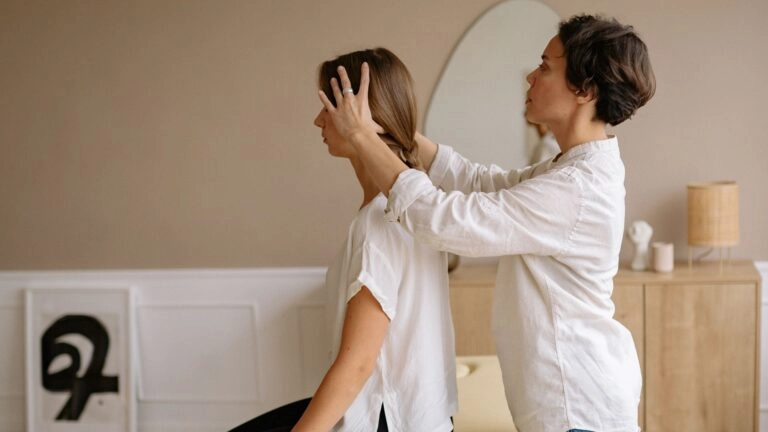If you suffer from labral tear hip pain at night, you may fear that there is no option for relief. But that’s not true. Your local Anchorage chiropractor can help.
The pain caused by a hip labral tear at night often can be successfully managed with a variety of conservative techniques and tips. These include such simple adjustments as choosing the correct sleeping position, choosing the right mattress, incorporating pillows, and doing the right kinds of exercises.
Why Is My Hip Labral Tear Pain Worse at Night?
Like many other musculoskeletal problems, hip labral tear pain can sometimes get worse at night. Why is this? Well, there are a number of different reasons.
First, one of the most critical elements of musculoskeletal health is spinal alignment. A healthy spine has a natural S-shaped curve that allows it to support the body properly. Misalignments of the spine can have ramifications throughout your entire musculoskeletal system. Further, when you sleep, a number of factors, like sleeping position, your mattress, and your pillows can affect your spinal alignment which, in turn, can affect things like the level of pain caused by a hip labral tear.
Second, when you sleep, your entire body relaxes and your amount of movement diminishes. So, your spine and body stay in the same position for extended periods of time. Typically, this gives the body a chance to recuperate from the stresses of the day. However, for some conditions, like a spinal misalignment, remaining in the same position may only serve to add stress and pressure to an area that truly needs relief.
The result of these factors is that the level of pain caused by an issue like a hip labral tear can increase. Indeed, sleeping with a hip labral tear is not unlike sleeping with SI joint pain. They can both be aggravated by very similar forces. If you want to know how to test if you have a hip labral tear, read our blog post here.
Anchorage Chiropractor Explains: What Is the Best Sleeping Position for Labral Tear Hip Pain?
As noted above, your sleeping position can sometimes have a significant impact on your spinal alignment, which, in turn, can impact your overall health. The first thing to recognize is that there are three basic sleeping positions: sleeping on your stomach, on your back, or on your side.
-
Sleeping On Your Stomach
This is actually the worst of the three options. It is just not good for your spinal alignment. First, you have to turn your head to breathe properly. This may not seem like much, but it places your upper spine out of alignment, which has ramifications throughout your entire spinal column. Second, many people, as they age, may develop a larger gut. If you sleep on your gut, the pressure that creates can push your lower spine out of alignment.
-
Sleeping On Your Back
Although this is better than sleeping on your back, you might have to avoid doing this, too, depending upon the location of your hip labral tear. If the tear is in the front of the hip (as most are), you’ll probably be fine. But some hip labral tears occur near the back of the hip. In such a case, if you sleep on your bank, you will be putting pressure on the tear – and that should be avoided.
-
Sleeping On Your Side
This also comes with a caveat. Don’t sleep on the side that has the hip labral tear. You will be putting pressure on it, if you do. Instead, sleep on your uninjured side so that the injured side can find relief.
That covers the basics of sleeping positions and pain caused by hip labral tears.
Some Tips Before Going To Bed with Labral Tear Hip Pain
There are a number of things you can do to help you sleep better when you are suffering from labral tear hip pain. First, you should ask yourself what actions you can take to reduce the pain over the long term. There are a few tips that will help in this regard.
-
Maintain a healthy body weight
This is good for all people not only those suffering from a hip labral tear. With respect to the hips, lowering your weight can reduce the amount of pressure put on your labrum and thus provide some relief from pain.
-
Start getting some exercise
This is also good for everyone. The thing to watch for, though, is to get medical advice on which exercise to do. Consulting your local Anchorage, AK chiropractor is a good place to start. There are good ones and bad ones for a hip labral tear. You want to make sure you do the correct hip labral tear exercises.
-
Seek out regular chiropractic care
Regular appointments with a local chiropractor in Anchorage can improve your spinal alignment and your corresponding musculoskeletal health. A chiropractor is an expert in the musculoskeletal system. As such, a chiropractor can, if he deems it likely to help, perform a hip adjustment on an injured individual to correct alignment and relieve pressure and pain. Chiropractors are also a good source of advice on the types of exercises (above) that will help your hip and its condition. Physical Therapists are another option for basically the same reasons.
That covers the long-term approach. In the short term, you might add a few brief stretching exercises like those found in yoga or similar activities. Again, consult a medical professional like a chiropractor, physical therapist, or general practitioner to guide your regimen.
Advice from Your Anchorage Chiropractor: Bed and Pillow Tips with Labral Tear Hip Pain
The type of mattress you sleep on and the type of pillow you use can also significantly affect your level of labral tear hip pain,
-
Mattress
You want a mattress that finds a happy medium between firmness and softness. A mattress that is too firm will not support your various curves and bumps. This can lead to misapplied pressure across the spine and can result in pain – not only in your hip labral tear, but elsewhere in your body as well. A mattress that is too soft will have similar problems. You want to sleep in a mattress that supports your spine properly in multiple sleeping positions.
-
Pillows for Your Neck
Your normal head pillow can, if not correctly chosen, cause issues with the alignment of your neck. If you sleep on your side, you should use a thicker pillow to keep your neck supported. If you sleep on your back, you should use a thinner pillow.
-
Pillows for Your Body
When you sleep on your side, you can take the extra step of placing a pillow between your knees to keep your hip better aligned at night – this should reduce some of your hip labral tear pain. If you sleep on your back, you can place the pillow under your knees for the same reason and result. Lastly, you can put a small pillow or towel under the small of your back, when sleeping on your back, or under your midsection when sleeping on your side. This may also help.
These tips and suggestions should help you deal with your labral tear hip pain at night. Overall, they are not unlike those you would use for other hip issues like a pinched nerve in the hip.
Now, let’s look at some of the science of hip labral tears.

Conservative Treatments of Hip Labral Tears
A study in the Journal of Bone and Joint Surgery found that in a group of 66 patients with a tears of the acetabular labrum, 71% (47) had night pain. Another study in the Physical Therapy & Rehabilitation Journal stated that “22% of athletes with groin pain9 and 55% of patients with mechanical hip pain of unknown etiology2 were found to have a labral tear…”
As in other areas of medicine, the rule of thumb is to try conservative therapies first in cases of hip labral tears. A study in MedNexus suggests the following list of conservative therapies: “rest, non-steroidal anti-inflammatory medication, pain medications, modification of activities, physical therapy, and intra-articular injection.”
Although surgery is typically needed to cure a hip labral tear, the pain such tears cause can be effectively managed by the above listed conservative therapies. A series of six case studies in the National Library of Medicine illustrate multiple examples where individuals with hip labral tears were treated with conservativmethods. The crucial point being: “At two years, none of the subjects had elected surgical management.”.
Conclusion:
I hope you find this information helpful. And, remember, as always, the best first step in any treatment is consultation with a qualified medical professional like those found at our Better Health Alaska offices. We are an Anchorage-based chiropractic facility with multiple types of providers and therapists, as well. So, reach out today.
Sources:









